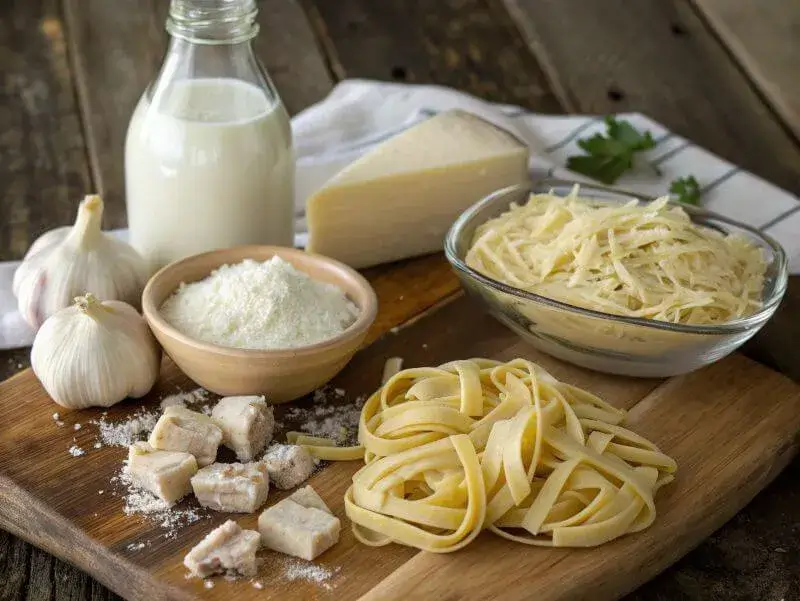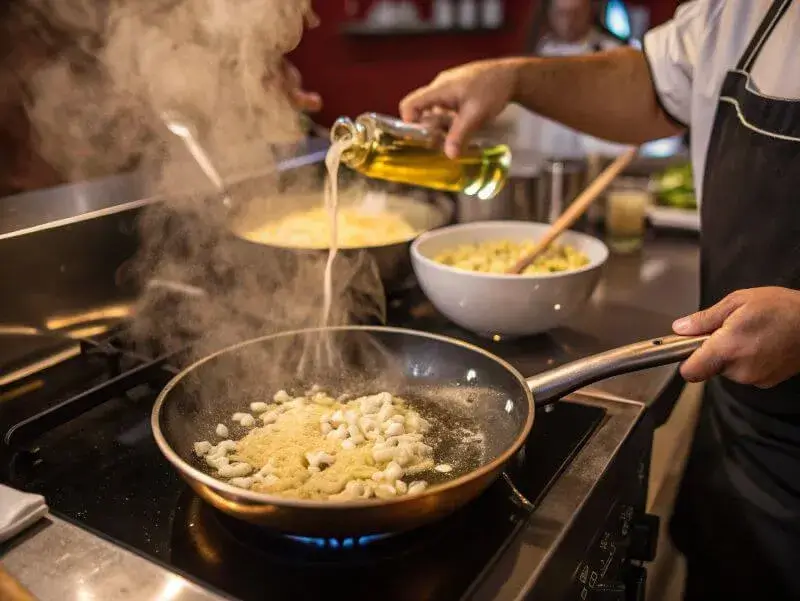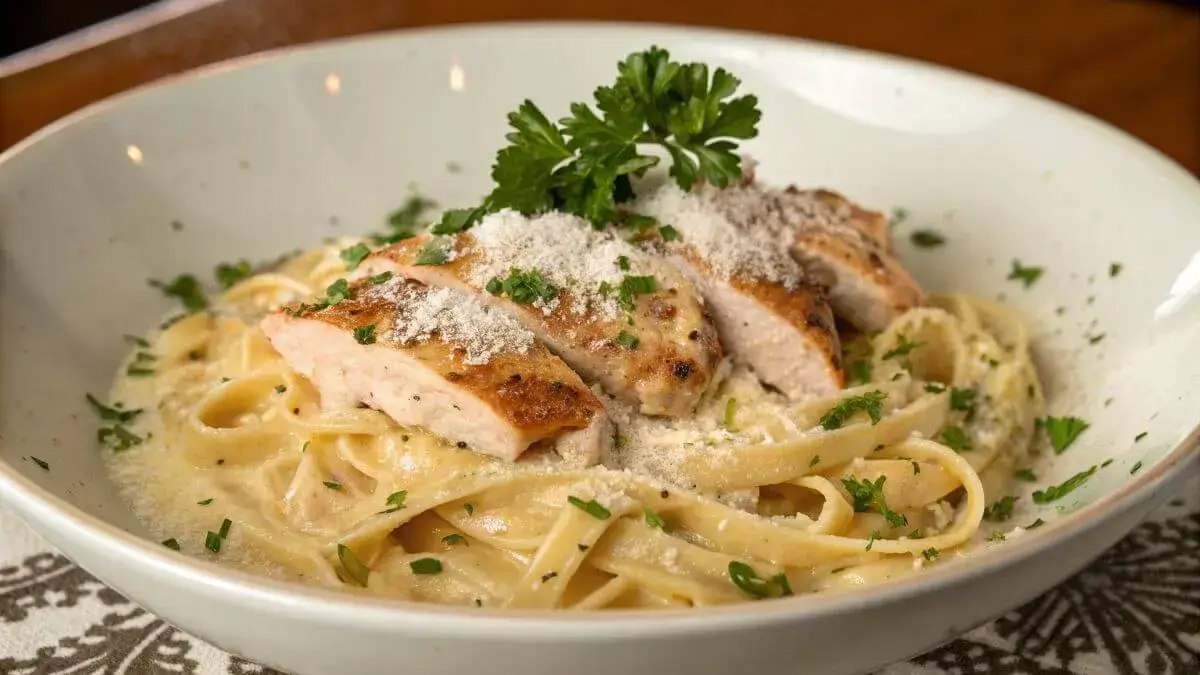Introduction
Ah, chicken Alfredo—the ultimate comfort food that’s creamy, dreamy, and oh-so-satisfying. But let’s face it: even this classic can fall flat if you’re not careful. Have you ever wondered why your homemade version doesn’t quite hit the mark like your favourite Italian restaurant? You’re not alone! The secret to what makes chicken Alfredo taste better lies in a mix of quality ingredients, innovative techniques, and a dash of creativity.
In this deep dive, we’ll crack the code of transforming bland to grand. From choosing the best Parmesan cheese to avoiding sauce-curdling disasters, we’ll cover everything—no stone left unturned. Whether you’re a weeknight warrior or a dinner party pro, these tips will turn your Alfredo into a showstopper. Ready to cook like a pro? Let’s get saucy!
The Role of Quality Ingredients in Perfect Chicken Alfredo

Choosing the Right Cheese: Fresh vs Pre-Grated Parmesan
You can’t build a mansion on a shaky foundation—and creamy Alfredo sauce is no different. The star here is Parmesan cheese, but not all Parmesan is created equal. Freshly grated Parmigiano-Reggiano packs a nutty, salty punch that pre-grated stuff can’t match. Why? Pre-shredded cheese often contains anti-caking agents like cellulose, which leave your sauce grainy. Pro tip: Grab a block and grate it yourself. Your taste buds will thank you.
Heavy Cream vs. Half-and-Half: Impact on Creaminess
Here’s the scoop: heavy cream is the MVP for that luxurious, velvety texture. Half-and-half might cut calories, but it’s thinner and risks splitting when heated. If you’re after restaurant-style Alfredo, stick with heavy cream. Try blending half-and-half with a splash of whole milk and a tablespoon of butter for a lighter twist. Compromise? Maybe. Delicious? Absolutely.
Selecting the Best Pasta for Alfredo Sauce
Not all noodles are born equal! Fettuccine is the classic choice—its flat, wide shape clings to the sauce like a cosy blanket. But linguine or tagliatelle work wonders, too. Avoid tube-shaped pasta (looking at you, penne)—they’ll let the sauce slide right off. And if you’re feeling fancy? Homemade pasta takes this dish from good to ”Is this heaven?”
Fresh Garlic vs. Powder: Flavor Depth in Alfredo Sauce
Garlic powder? In my Alfredo? Hard pass. Fresh garlic minced fine and sautéed gently in butter or olive oil adds a sweet, aromatic depth that powder can’t replicate. Burn it, though, and you’ll get bitterness haunting your sauce. Low and slow is the way to go!
Why Chicken Breast Quality Matters
Dry, rubbery chicken ruins the party. Opt for organic, free-range breasts—they’re juicier and more flavorful. Brining (soaking in salt water) for 30 minutes before cooking? Game-changer. It locks in moisture, ensuring every bite is tender. Skip the brine, and you’re rolling the dice on sad, stringy meat.
Cooking Techniques That Elevate Chicken Alfredo Flavor

Sautéing Garlic Properly: Avoiding Burnt or Raw Tastes
Let’s cut to the chase: burnt garlic is the arch-nemesis of creamy Alfredo sauce. Start by heating your pan on medium-low—no rocket science here. Add minced garlic to melted butter or olive oil and stir for 30 seconds. If it turns golden too fast, yank that pan off the heat! Raw garlic, on the other hand, leaves a harsh bite. Nail this step, and you’re halfway to answering what makes chicken Alfredo taste better.
The Art of Simmering: Balancing Sauce Thickness and Richness
Once your cream hits the pan, patience is key. Crank the heat too high, and you’ll split the sauce faster than a dropped plate. Instead, let it gently simmer—tiny bubbles, not a rolling boil—while stirring in Parmesan gradually. This low-and-slow approach melts the cheese smoothly, giving you a velvety texture that clings to the pasta. Pro tip: If your sauce thickens too much, splash in reserved pasta water. It’s liquid gold for rescuing consistency!
Perfectly Cooked Chicken: Juicy vs. Overdone Texture
Dry chicken? Hard pass. Pound breasts to even thickness before seasoning with salt and pepper for succulent bites. Sear them in a hot skillet until golden (about 5-6 minutes per side), then rest for 5 minutes before slicing. Resting locks in juices, so you’re not left with sad, stringy meat. Pair this with the garlic Parmesan sauce, and you’ve got a match made in foodie heaven.
Tossing Pasta in Sauce: Ensuring Even Flavor Distribution
Here’s where the magic happens: never dump sauce on noodles. Instead, add cooked pasta directly to the skillet with the Alfredo sauce. Use tongs to toss and fold like you’re kneading dough. This coats every strand evenly, so each bite screams ” flavour bomb”. Bonus: The starch from the pasta water helps the sauce stick like glue.
Deglazing the Pan: Unlocking Fond for Richer Sauce
After searing chicken, don’t waste those crispy brown bits stuck to the pan—they’re flavour gold! Splash a little white wine or broth into the hot skillet and scrape with a wooden spoon. Mix this fond into your sauce for a savoury depth that’ll make you wonder, ”Why didn’t I do this sooner?”
Flavor Boosters to Make Chicken Alfredo Taste Better
Adding Nutmeg or White Pepper: Subtle Spice Enhancements
A pinch of nutmeg might sound odd, but trust me—it’s the secret weapon for creamy Alfredo sauce. This warm spice cuts through richness without shouting its presence. White pepper works similarly, adding mild heat without black specks ruining your pristine sauce. Just a dash, though—you’re enhancing, not overpowering!
Fresh Herbs vs. Dried: Basil, Parsley, or Thyme Pairings
Dried herbs? Save ’em for winter stews. For Alfredo, fresh parsley or basil adds a bright, grassy contrast to the decadent sauce. Chop them finely and stir in at the end for maximum vibrancy. Thyme’s earthy notes also pair beautifully, but go easy—its piney flavour can dominate if you’re heavy-handed.
Lemon Zest or Juice: Brightening Creamy Alfredo Sauce
A squeeze of lemon juice or a sprinkle of zest is like sunshine in a bowl. The acidity balances the heaviness of the cream, making each bite feel lighter. Don’t go overboard—start with ½ teaspoon of zest or a tablespoon of juice. Taste as you go because harmony, not a citrus punch, makes chicken Alfredo taste better.
Crispy Pancetta or Bacon: Adding Smoky Depth
Bacon isn’t just for breakfast—it’s a game-changer for Alfredo. Cook diced pancetta or bacon until crispy, then use the rendered fat to sauté your garlic. Sprinkle the crunchy bits on top for a salty, smoky crunch. It’s like giving your taste buds a high-five with every forkful.
Mushrooms or Spinach: Vegetarian Twists for Complexity
Want to sneak in veggies without a mutiny? Sauté sliced mushrooms until golden and fold them into the sauce—their umami richness pairs perfectly with Parmesan. Baby spinach? Toss it in raw during the final toss; the residual heat wilts it gently. Either way, you’re adding layers of flavour and texture that answer what makes chicken Alfredo taste better.
Common Mistakes That Ruin Chicken Alfredo
Overheating the Sauce: Curdling Risks and Fixes
Let’s get real: nothing kills the vibe of creamy Alfredo sauce faster than curdling. High heat is the culprit here. When you crank up the stove, the proteins in the cream and cheese separate, leaving you with a grainy, lumpy mess. To avoid this, always simmer on low heat. If disaster strikes, whisk in a cold cream or pasta water splash to bring it back together. Remember, patience is your best friend when answering what makes chicken Alfredo taste better.
Underseasoning: How to Correct Bland Alfredo
Bland Alfredo? No, thank you. Salt is your secret weapon, but timing matters. Season your chicken while cooking, and add a pinch of salt to the sauce as it simmers. Taste as you go—Parmesan adds saltiness, so adjust accordingly. A sprinkle of flaky sea salt on top can work wonders if you’ve already plated and it’s still blah.
Overcrowding the Pan: Why Batch Cooking Chicken Matters
Trying to cook all your chicken at once? Big mistake. Overcrowding the pan drops the temperature, leading to steamed, soggy meat instead of that golden sear we crave. Cook in batches if needed, and let each piece have its moment to shine. This ensures juicy, flavorful chicken that pairs perfectly with your garlic Parmesan sauce.
Using Starchy Pasta Water Incorrectly
Pasta water is a lifesaver—but only if you use it right. Don’t dump it all in at once. Add it gradually, tossing the pasta as you go, until the sauce reaches your desired consistency. Too much, and your Alfredo turns into soup. Too little, and it’s clumpy. Balance is key!
Creative Variations to Upgrade Chicken Alfredo
Buffalo Chicken Alfredo: Adding Spicy Tang
Love a little heat? Toss shredded chicken in buffalo sauce before mixing it into your Alfredo. The tangy, spicy kick cuts through the richness, creating a flavour explosion. Top with crumbled blue cheese and green onions for the ultimate game-day twist.
Sun-Dried Tomato and Spinach Alfredo
For a veggie-packed upgrade, stir in chopped sun-dried tomatoes and fresh spinach. The tomatoes add a sweet-tart punch, while the spinach brings colour and nutrients. It’s a win-win for flavour and health!
Lobster or Shrimp Alfredo for a Gourmet Flair
Feeling fancy? Swap chicken for lobster or shrimp. Sauté the seafood in garlic butter, then fold it into the sauce. It’s a luxurious twist perfect for date night or impressing guests.
Gluten-Free or Vegan Alfredo Alternatives
Dietary restrictions? No problem. Use gluten-free pasta and swap heavy cream for cashew cream or coconut milk. Nutritional yeast can replace Parmesan for a cheesy, vegan-friendly flavour. You don’t have to miss out on what makes chicken Alfredo taste better—adapt!
Serving and Pairing Ideas for Chicken Alfredo
Best Side Dishes: Garlic Bread, Salads, or Roasted Veggies
Let’s be honest: chicken Alfredo is rich, creamy, and indulgent. Balance it out with sides that cut through the heaviness. Garlic bread is a no-brainer—its crispy, buttery goodness is perfect for mopping up every last drop of sauce. A fresh Caesar salad or a tangy arugula salad with lemon vinaigrette adds a refreshing contrast. For something heartier, try roasted veggies like broccoli or asparagus. They’re simple, healthy, and pair beautifully with the dish.

Wine Pairings: Chardonnay, Pinot Grigio, or Sparkling Wines
Wondering what to sip with your Alfredo? A buttery Chardonnay complements the creamy sauce, while a crisp Pinot Grigio cuts through the richness. If you’re feeling fancy, a glass of Prosecco or Champagne adds a festive touch. The bubbles cleanse your palate, making each bite taste as good as the first.
Garnishing Tips: Fresh Parsley, Red Pepper Flakes, or Truffle Oil
Don’t skip the garnish—the finishing touch elevates your dish. A sprinkle of fresh parsley adds colour and a hint of freshness. For a spicy kick, dust with red pepper flakes. Feeling luxurious? A drizzle of truffle oil takes your Alfredo to gourmet status. These small touches answer what makes chicken Alfredo taste better by adding layers of flavour and visual appeal.
FAQs: Answering Top “People Also Ask” Questions
Can I substitute heavy cream for chicken Alfredo?
Absolutely! While heavy cream is traditional, you can use half-and-half or whole milk for a lighter version. Just add a tablespoon of butter to boost richness. For a dairy-free option, try cashew cream or coconut milk.
How do I reheat Alfredo sauce without separating it?
Reheating Alfredo can be tricky, but it’s doable. Use a saucepan on low heat, stirring constantly. Add a splash of milk or cream to loosen the sauce. Avoid the microwave—it’s a one-way ticket to grainy, separated sauce.
Why does my Alfredo sauce taste grainy?
The grainy sauce usually means the cheese was added too quickly or the heat was too high. Grate your Parmesan finely and add it gradually to warm (not boiling) cream. Stir until thoroughly melted before adding more.
Is chicken Alfredo an authentic Italian dish?
Not exactly. While Alfredo sauce has Italian roots, chicken Alfredo is an American twist. Traditional Fettuccine Alfredo is more straightforward—just butter, Parmesan, and pasta. Still delicious, but not the same as the creamy version we love.
What’s the best way to store leftover chicken Alfredo?
Store leftovers in an airtight container in the fridge for up to 3 days. Reheat gently on the stove with a splash of milk or cream to restore creaminess. Avoid freezing—the sauce tends to separate when thawed.
Pro Tips for Perfect Chicken Alfredo Every Time
Use Freshly Grated Parmesan for Maximum Flavor
Pre-grated Parmesan might save time, but it’s a shortcut that sacrifices flavour. Freshly grated Parmigiano-Reggiano melts smoothly, adding a nutty, salty depth that pre-packaged cheese can’t match. Plus, it avoids the anti-caking agents that make your sauce grainy. This is a non-negotiable step if you’re serious about what makes chicken Alfredo taste better.
Don’t Skip the Pasta Water
That starchy water isn’t just for boiling pasta—it’s a secret weapon for your sauce. A splash of pasta water helps the sauce cling to the noodles, creating a silky, cohesive dish. Reserve about ½ cup before draining your pasta, and add it gradually as you toss everything together.
Let the Sauce Rest Before Serving
Patience pays off. After combining the sauce and pasta, let it sit off the heat for 2-3 minutes. This allows the flavours to meld and the sauce to thicken slightly. Rushing this step can leave your Alfredo tasting one-dimensional.
Why Chicken Alfredo is a Crowd-Pleasing Classic
It’s Comfort Food at Its Finest
There’s a reason chicken Alfredo is a go-to for family dinners and date nights alike. The creamy sauce, tender chicken, and perfectly cooked pasta hit all the right notes—rich, satisfying, and oh-so-comforting. It’s the dish that feels like a warm hug on a plate.
Endless Customization Options
One of the best things about Alfredo is how versatile it is. Whether adding veggies like spinach and mushrooms, swapping chicken for shrimp, or making it vegan with plant-based ingredients, there’s a version for everyone. This adaptability is a big part of what makes chicken Alfredo taste better—it’s a dish that can evolve with your tastes.
Easy to Make, Hard to Mess Up
Alfredo is forgiving and straightforward, even if you’re not a seasoned chef. With just a handful of ingredients and a few simple steps, you can whip up a dish that feels gourmet. Plus, it’s a great way to impress guests without spending hours in the kitchen.

